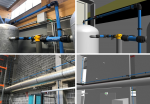Parker Transair® has been a specialist in modular piping systems for utility fluid networks for more than 25 years. A global player, this manufacturer is the first on the market to provide BIM services to building professionals, for industrial fluid systems.

Gaël Le Carrer, a Transair® Project Support specialist, shares with us his vision for the collaboration between Transair® and BIM&CO. The Transair® Project Support Team is an expert in the field of utility fluids. It provides technical support, by means of dedicated studies and modelling, from the design of piping system projects, through to their costing and execution.
 Transair® has seized the opportune moment to digitalise its products, in order to respond to the needs of design consultancy firms, contractors, and installers, who are looking to improve their processes using the BIM method. The manufacturer wanted, first and foremost, to improve its partners’ customer experience: “As a premium brand, we wanted to get a head start, and to offer more turnkey solutions, to continually offer more added value to our customers.”, explains Gaël Le Carrer.
Transair® has seized the opportune moment to digitalise its products, in order to respond to the needs of design consultancy firms, contractors, and installers, who are looking to improve their processes using the BIM method. The manufacturer wanted, first and foremost, to improve its partners’ customer experience: “As a premium brand, we wanted to get a head start, and to offer more turnkey solutions, to continually offer more added value to our customers.”, explains Gaël Le Carrer.
BIM also represented a genuine differentiating factor for Transair®, with regard to the competition, who had not yet taken the leap.
As a result of these differing requirements, and convinced of the importance of BIM data, the idea of marketing its products using this new, digital format was born.
Transair® thus teamed up with BIM&CO on account of its technical expertise, the unique technology of its online BIM objects platform, and its international reach: “We wanted to offer objects with correctly and well-provided data and geometry, enabling for installers and design offices to save time when it comes to the modeling of fluids”, comments Gaël Le Carrer. This shared vision with BIM&CO lead to the creation of a template, which serves as a catalogue of Transair® smart objects.
“We wanted to combine all of our products under a single banner, enabling any user to access our entire, up-to-date library, with just one click. The Revit smart template proposed by BIM&CO therefore stood out as the perfect solution for us”, adds Gaël Le Carrer.
 A novice when it came to BIM, this initiative was not without obstacles for Transair® : “It was a leap into the unknown. We had to quickly gain a grasp of the BIM philosophy, the market requirements, and therefore adapt in order to fully engage with the BIM process as a manufacturer. Our team also had to master new tools, such as Revit‘’, explains Gaël Le Carrer.
A novice when it came to BIM, this initiative was not without obstacles for Transair® : “It was a leap into the unknown. We had to quickly gain a grasp of the BIM philosophy, the market requirements, and therefore adapt in order to fully engage with the BIM process as a manufacturer. Our team also had to master new tools, such as Revit‘’, explains Gaël Le Carrer.
The challenge posed by new tools didn’t end with the training, but rather continued with the actual use of the software and the template. BIM&CO stepped up to the mark and supported Transair® in the early days of using the template, in particular with error corrections upon launch, and the subsequent updating of the template. Gaël Le Carrer attests : “After that, we had to keep up with developments, and continue with the optimisation, with the updating of the data, of the objects, with the addition of new features, and always maintaining communication to encourage the downloading and use of our template.”
 The template is aimed at various professionals, acting within all phases of the life of a building, from the design, to its construction, use, and maintenance. For example, design offices that stipulate the use of their networks upstream of projects can directly integrate Transair® elements into their 3D model for the tender document. Furthermore, installers can integrate the Transair® network into implementation and as-built record models in an optimal fashion, with precisely dimensioned elements and a realistic representation.
The template is aimed at various professionals, acting within all phases of the life of a building, from the design, to its construction, use, and maintenance. For example, design offices that stipulate the use of their networks upstream of projects can directly integrate Transair® elements into their 3D model for the tender document. Furthermore, installers can integrate the Transair® network into implementation and as-built record models in an optimal fashion, with precisely dimensioned elements and a realistic representation.
The smart template groups together all of the Transair® parts.
It integrates sophisticated features and settings, such as route preferences that define how the objects interact. This consequently enables the fast and simple integration of the networks within the BIM digital models, in accordance with the technical constraints of the project. In terms of quality, the Transair®‘s team is very impressed:“The representation of the objects is true to our products, and the injected data allows us to find useful information.”


The Transair® Project Support Team also uses the template. Firstly, this is to offer a network modelling service directly within its customers’ BIM models, thus working alongside the various project players. Secondly, they use it to conduct complex technical studies, with a high level of detail and precision.
‘’BIM, and in particular the Revit tool, allows us to produce more sophisticated designs and studies, more quickly and with higher-quality images. The recovery of the list of equipment directly within Revit is also a considerable advantage’’, adds the Transair® team.
Being satisfied with this partnership with BIM&CO, Transair® is now able to expand into new markets, in particular “BIM only”, and also reach new partners.
You can download the complete data and properties for each Transair® BIM object on the bimandco.com plateform, via this link. If you want to know more about BIM&CO solutions, , contact their consultation service.
You can also find information on the Transair® BIM solutions via this link.
